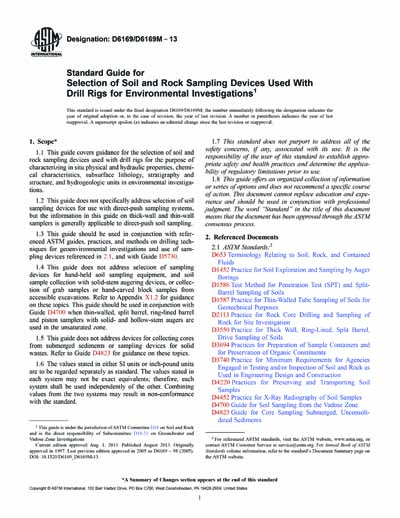Most recent
ASTM D6169/D6169M-13
Standard Guide for Selection of Soil and Rock Sampling Devices Used With Drill Rigs for Environmental Investigations
1.1 This guide covers guidance for the selection of soil and rock sampling devices used with drill rigs for the purpose of characterizing in situ physical and hydraulic properties, chemical characteristics, subsurface lithology, stratigraphy and structure, and hydrogeologic units in environmental investigations.
1.2 This guide does not specifically address selection of soil sampling devices for use with direct-push sampling systems, but the information in this guide on thick-wall and thin-wall samplers is generally applicable to direct-push soil sampling.
1.3 This guide should be used in conjunction with referenced ASTM guides, practices, and methods on drilling techniques for geoenvironmental investigations and use of sampling devices referenced in 2.1, and with Guide D5730.
1.4 This guide does not address selection of sampling devices for hand-held soil sampling equipment, and soil sample collection with solid-stem augering devices, or collection of grab samples or hand-carved block samples from accessible excavations. Refer to Appendix X1.2 for guidance on these topics. This guide should be used in conjunction with Guide D4700 when thin-walled, split barrel, ring-lined barrel and piston samplers with solid- and hollow-stem augers are used in the unsaturated zone.
1.5 This guide does not address devices for collecting cores from submerged sediments or sampling devices for solid wastes. Refer to Guide D4823 for guidance on these topics.
1.6 The values stated in either SI units or inch-pound units are to be regarded separately as standard. The values stated in each system may not be exact equivalents; therefore, each system shall be used independently of the other. Combining values from the two systems may result in non-conformance with the standard.
1.7 This standard does not purport to address all of the safety concerns, if any, associated with its use. It is the responsibility of the user of this standard to establish appropriate safety and health practices and determine the applicability of regulatory limitations prior to use.
1.8 This guide offers an organized collection of information or series of options and does not recommend a specific course of action. This document cannot replace education and experience and should be used in conjunction with professional judgment. The word “Standard” in the title of this document means that the document has been approved through the ASTM consensus process.
Content Provider
ASTM International [astm]






